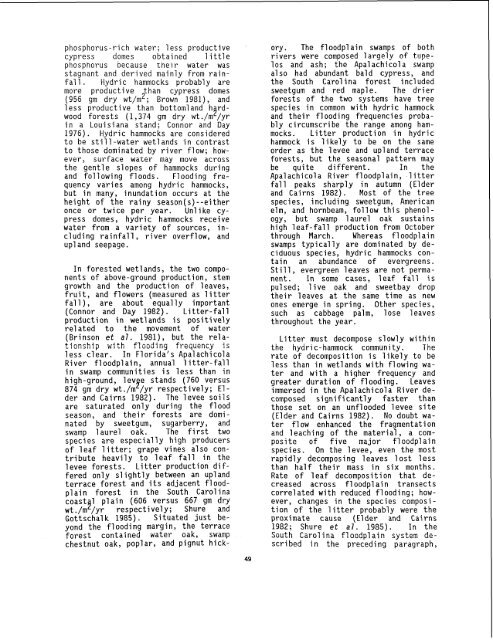The Ecology of Hydric Hammocks - USGS National Wetlands ...
The Ecology of Hydric Hammocks - USGS National Wetlands ...
The Ecology of Hydric Hammocks - USGS National Wetlands ...
You also want an ePaper? Increase the reach of your titles
YUMPU automatically turns print PDFs into web optimized ePapers that Google loves.
phosphorus-rich water; less productivecypress domes obtained 1 i ttlephospnorus aecause tneir water wasstagnant and derived mainly from rainfa1l . <strong>Hydric</strong> hammocks probably aremore productive than cypress domes(956 gm dry wt/m2; Brown 19811, and1 ess productive than bottom1 and h rdwood forests (1,374 gm dry wt./m 5 /yr-in a Louisiana stand; Connor and Day1976). <strong>Hydric</strong> hammocks are consideredto be still-water wetlands in contrastto those dominated by river flow; however,surface waEer may move acrossthe gentle slopes <strong>of</strong> hammocks duringand following floods. Flooding frequencyvaries among hydric hammocks,but in many, inundation occurs at theheight <strong>of</strong> the rainy season(s) --ei theronce or twice per year. Unlike cypressdomes, hydric hammocks receivewater from a variety <strong>of</strong> sources, includingrainfall, river overflow, andup1 and seepage.In forested wetlands, the two components<strong>of</strong> above-ground production, stemgrowth and the production <strong>of</strong> leaves,fruit, and flowers (measured as litterfa1 1 ) , are about equally important(Connor and Day 1982). Li tter-fallproduction in wet1 ands is positivelyrelated to the movement <strong>of</strong> water(Brinson et a7. 1981), but the relationshipwith flooding frequency isless clear. In Florida's ApalachicolaRiver floodplain, annual 1 i tter-fallin swamp communities is less than inhigh-ground, lev e stands (760 versus874 gm dry wt ./m 2 /yr respectively; El -der and Cairns 1982). <strong>The</strong> 1 evee soilsare saturated only during the floodseason, and their forests are dominatedby sweetgum, sugarberry, andswamp laurel oak. <strong>The</strong> first twospecies are especial? y high producers<strong>of</strong> leaf 1 itter; grape vines also contributeheavily to leaf fall in the1 evee forests. Litter production di f-fered only slightly between an uplandterrace forest and its adjacent floodplainforest in the South Carolinacoast 1 plain (606 versus 667 gm drywt./m/yr ? respectively; Shure andGottschal k 1985). Situated just beyondthe flooding margin, the terraceforest contained water oak, swampchestnut oak, poplar, and pignut hick-ory. <strong>The</strong> floodplain swamps <strong>of</strong> bothrivers were composed largely <strong>of</strong> tupelosand ash; the Apalachicola swampalso had abundant bald cypress, andthe South Carol ina forest includedsweetgum and red maple. <strong>The</strong> drierforests <strong>of</strong> the two systems have treespecies in common with hydric hammockand their flooding frequencies probablycircumscribe the range among hammocks.Litter production in hydrichammock is likely to be on the sameorder as the levee and upland terraceforests, but the seasonal pattern maybe quite different. In theApal achicol a River floodplain, 1 i tterfall peaks sharply in autumn (Elderand Cairns 1982). Most <strong>of</strong> the treespecies, including sweetgum, Americanelm, and hornbeam, follow this phenol -ogy, but swamp laurel oak sustainshigh leaf-fa1 1 production from Octoberthrough March. Whereas floodplainswamps typically are dominated by deciduousspecies, hydric hammocks containan abundance <strong>of</strong> evergreens.Still , evergreen 1 eaves are not permanent.In some cases, leaf fall ispulsed; 1 ive oak and sweetbay droptheir leaves at the same time as newones emerge in spring. Other species,such as cabbage palm, lose leavesthroughout the year.Litter must decompose slowly withinthe hydric-hammock community. <strong>The</strong>rate <strong>of</strong> decomposition is likely to beless than in wetlands with flowing waterand with a higher frequency andgreater duration <strong>of</strong> flooding . Leavesimmersed in the Apalachicola River decomposedsignificantly faster thanthose set on an unflooded levee site(Elder and Cairns 1982). No doubt waterflow enhanced the fragmentationand leaching <strong>of</strong> the material, a composite<strong>of</strong> five major floodplainspecies. On the levee, even the mostrapidly decomposing leaves 1 ost lessthan half their mass in six months.Rate <strong>of</strong> leaf decomposition that decreasedacross floodpl ain transectscorrel ated with reduced flooding; however,changes in the species composition<strong>of</strong> the litter probably were theproximate cause (Elder and Cairns1982; Shure et al. 1985). In theSouth Carolina floodplain system describedin the preceding paragraph,

















